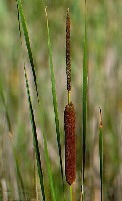| DESCRIPTION: It is a long-lived, perennial, aquatic, colonial, rhizomatous herb reaching 1.2-1.5 m or even 3 m in height. It has long, slender, and green stalks topped with brown, fluffy, sausage-shaped flowering heads (spikes). The staminate and pistillate portions of the spike are separated by 1-8 cm of bare stem. The spike is medium to dark brown. USE: All parts of the plant are edible; the leaves can be used in weaving of mats etc; all parts of the plant have medicinal properties and the plant is used for waste water treatment. GROWING PERIOD: Long-lived perennial. COMMON NAMES: Small reed mace, Narrow-leaved cattail, Lesser bulrush. FURTHER INF: It is found in or near water, in marshes, ponds, lakes, and depressional areas. It is an obligate wetland indicator plant species. It tolerates perennial flooding, reduced soil conditions, and moderate salinity. It will often form an almost complete monoculture in boggy soil and may form floating mats. It grows in water or poorly drained soil. It thrives in rich soils but is of shallow soil, all types of soil textures and medium salinity. With influxes of nutrients or freshwater, it is an aggressive invader in both brackish salt marshes and freshwater wetlands. It can be found throughout North America, Eurasia, southern Scandinavia and northern Africa. |
